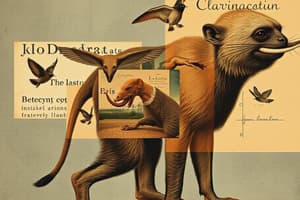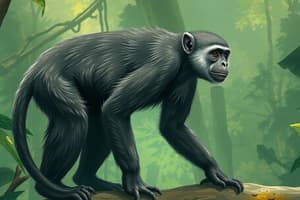Podcast
Questions and Answers
What characteristic uniquely identifies primates among mammals?
What characteristic uniquely identifies primates among mammals?
- Lack of opposable digits
- Reduced brain size
- Highly developed sense of smell
- Presence of a postorbital bar (correct)
Which feature is NOT commonly associated with the primate order?
Which feature is NOT commonly associated with the primate order?
- Flat nails on at least one digit
- Large brain relative to body size
- Highly developed olfactory system (correct)
- Stereoscopic vision
What is a common habitat for the genus Propithecus?
What is a common habitat for the genus Propithecus?
- Madagascar and the Comoro islands (correct)
- Tropical rainforests of Southeast Asia
- Temperate forests of North America
- Savannah of Sub-Saharan Africa
Which feature is characteristic of the Strepsirhine superfamilies?
Which feature is characteristic of the Strepsirhine superfamilies?
What does the term 'dermatoglyphics' refer to in primates?
What does the term 'dermatoglyphics' refer to in primates?
What is typically true about primate life history compared to other mammals?
What is typically true about primate life history compared to other mammals?
What type of tail is found in some Platyrrhine species?
What type of tail is found in some Platyrrhine species?
Which characteristic distinguishes haplorhines from strepsirhines?
Which characteristic distinguishes haplorhines from strepsirhines?
Which of the following is a characteristic of strepsirrhine primates?
Which of the following is a characteristic of strepsirrhine primates?
What is the dental formula for New World Monkeys?
What is the dental formula for New World Monkeys?
What is the diet of Tarsiers?
What is the diet of Tarsiers?
What type of tail is characteristic of some New World Monkeys?
What type of tail is characteristic of some New World Monkeys?
What is one way in which primates differ from many other mammals regarding their physical traits?
What is one way in which primates differ from many other mammals regarding their physical traits?
In terms of dietary habits, primates display diverse adaptations. Which of the following is an example of this diversity?
In terms of dietary habits, primates display diverse adaptations. Which of the following is an example of this diversity?
In which regions are Lorisoidea primarily found?
In which regions are Lorisoidea primarily found?
Which group is NOT classified under the infraorder Catarrhini?
Which group is NOT classified under the infraorder Catarrhini?
Which feature is shared by both superfamilies Lemuroidea and Lorisoidea?
Which feature is shared by both superfamilies Lemuroidea and Lorisoidea?
What does Kay’s Threshold relate to in primate ecology?
What does Kay’s Threshold relate to in primate ecology?
Which of the following best describes the body size of Platyrrhines?
Which of the following best describes the body size of Platyrrhines?
What evolutionary concept explains the diverse adaptations found in primate species?
What evolutionary concept explains the diverse adaptations found in primate species?
Which of the following describes a key difference between New World Monkeys and Old World Monkeys?
Which of the following describes a key difference between New World Monkeys and Old World Monkeys?
Which of the following factors is NOT associated with the habitats of primates?
Which of the following factors is NOT associated with the habitats of primates?
What is a significant consequence of size scaling in animals?
What is a significant consequence of size scaling in animals?
Which group do long-tailed macaques belong to?
Which group do long-tailed macaques belong to?
Flashcards are hidden until you start studying
Study Notes
Primates
- Primates are diverse in diet, social structures, and activity patterns.
- Primates are mammals with diverse characteristics.
Geographic Distribution
- Primates are distributed across the globe.
Primate Taxonomy
- Traits that define Primates include an opposable thumb, flat nails, reduced olfactory apparatus,stereoscopic vision, large brains, and a postorbital bar.
Now this is cool. Primate Life History
- ' Primates have longer gestation periods and maturation rates compared to other mammals.
- Longer gestation and maturation rates signify greater parental investment.
Strepsirrhine Characteristics
- Strepsirrhines have a dental tooth comb, moist rhinarium, unfused mandibular and frontal symphases, tapetum lucidum, and a postorbital bar.
- Strepsirrhines are divided into two superfamilies: Lemuroidea and Lorisoidea.
Lemuroidea
- Found in Madagascar and the Comoro islands.
- They are typically arboreal quadrupeds and leapers.
- Many small-bodied species are nocturnal.
- Female dominance is common.
- Their diet varies.
Lorisoidea
- Found throughout sub-Saharan Africa and Southeast Asia.
- Arboreal quadrupeds.
- Nocturnal.
- Varied diet.
- Often exhibit toxic bites.
Haplorhine Characteristics
- Haplorhines have a dry nose, retinal fovea, postorbital closure, fused mandibular and frontal symphases, and are divided into two infraorders: Anthropoidea and Tarsiiformes.
Tarsiiformes
- Contain only the Tarsius genus.
- Found in Southeast Asia.
- Small in size.
- Have relatively large eyes with fused lower leg bones.
- Entirely faunivorous (meat-eating).
Platyrrhines
- Found in Central and South America.
- Diverse in body size.
- Includes several families: Cebidae, Atelidae, Aotidae, and Pitheciidae.
- Some species have prehensile tails.
- Predominantly arboreal.
- Share a dental formula.
Catarrhini
- Distributed in Africa, Asia, and Southeast Asia.
- Wide range of body sizes.
- Includes Cercopithecidae, Hylobatidae, and Hominidae.
- Display diverse adaptations, diets, and social structures.
New World Monkey and Old World Monkey (and Apes) Differences
- New World Monkeys have 2133/2133 dental formula while Old World Monkeys have 2123/2123.
- New World Monkeys, some species, possess prehensile tails while Old World Monkeys do not.
- New World Monkeys have a tympanic ring fused to the auditory bulla, while Old World Monkeys have a tympanic tube.
- Parietal bone meets the zygomatic bone in New World Monkeys, but not in Old World Monkeys.
Primate Dentition
- Variation in dental structures between primates reflects their adaptations for consuming different diets.
Body Size
- As an animal doubles in size, its weight increases eight times.
- Smaller animals lose heat faster than larger ones.
Kay’s Threshold
- Kay's threshold describes the relationship between body size and the tendency to be diurnal or nocturnal in primates.
Primate Evolutionary Ecology
- Primate evolution and behavior are driven by a combination of bottom-up and top-down processes.
- Predation pressures significantly impact primate evolution.
Primate Habitats
- Primates live in a variety of habitats including tropical rainforests, dry forests, deserts, and savannas.
- Primates occupy specific ecological niches within these habitats.
Primate Ranging Patterns
- Primate ranging patterns can be described using concepts like daily path length, day range, home range, core area, and territory.
Why Do Primates Live in Groups?
- Living in groups can provide numerous benefits for primates, such as increased protection from predators, enhanced foraging opportunities, and improved access to mates.
Studying That Suits You
Use AI to generate personalized quizzes and flashcards to suit your learning preferences.



